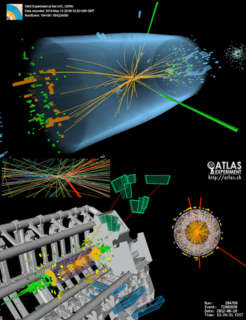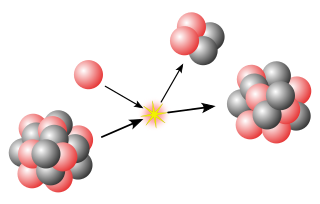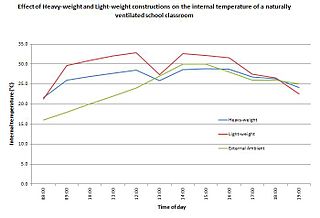 W
WMass is both a property of a physical body and a measure of its resistance to acceleration when a net force is applied. An object's mass also determines the strength of its gravitational attraction to other bodies.
 W
WThe atomic mass is the mass of an atom. Although the SI unit of mass is kilogram, the atomic mass is often expressed in the non-SI unit dalton where 1 dalton is defined as 1⁄12 of the mass of a single carbon-12 atom, at rest. The protons and neutrons of the nucleus account for nearly all of the total mass of atoms, with the electrons and nuclear binding energy making minor contributions. Thus, the numeric value of the atomic mass when expressed in daltons has nearly the same value as the mass number. Conversion between mass in kilograms and mass in daltons can be done using the atomic mass constant .
 W
WIn astronomy, the barycenter is the center of mass of two or more bodies that orbit one another and is the point about which the bodies orbit. It is an important concept in fields such as astronomy and astrophysics. The distance from a body's center of mass to the barycenter can be calculated as a two-body problem.
 W
WBrain-to-body mass ratio, also known as the brain-to-body weight ratio, is the ratio of brain mass to body mass, which is hypothesized to be a rough estimate of the intelligence of an animal, although fairly inaccurate in many cases. A more complex measurement, encephalization quotient, takes into account allometric effects of widely divergent body sizes across several taxa. The raw brain-to-body mass ratio is however simpler to come by, and is still a useful tool for comparing encephalization within species or between fairly closely related species.
 W
WIn physics, the center of mass of a distribution of mass in space is the unique point where the weighted relative position of the distributed mass sums to zero. This is the point to which a force may be applied to cause a linear acceleration without an angular acceleration. Calculations in mechanics are often simplified when formulated with respect to the center of mass. It is a hypothetical point where the entire mass of an object may be assumed to be concentrated to visualise its motion. In other words, the center of mass is the particle equivalent of a given object for application of Newton's laws of motion.
 W
WIn physics and chemistry, the law of conservation of mass or principle of mass conservation states that for any system closed to all transfers of matter and energy, the mass of the system must remain constant over time, as the system's mass cannot change, so quantity can neither be added nor be removed. Therefore, the quantity of mass is conserved over time.
 W
WA counterweight is a weight that, by applying an opposite force, provides balance and stability of a mechanical system. The purpose of a counterweight is to make lifting the load faster and more efficient, which saves energy and is less taxing on the lifting machine.
 W
WA critical mass is the smallest amount of fissile material needed for a sustained nuclear chain reaction. The critical mass of a fissionable material depends upon its nuclear properties, density, shape, enrichment, purity, temperature, and surroundings. The concept is important in nuclear weapon design.
 W
WThe Higgs boson is an elementary particle in the Standard Model of particle physics produced by the quantum excitation of the Higgs field, one of the fields in particle physics theory. It is named after physicist Peter Higgs who in 1964 along with five other scientists proposed the Higgs mechanism to explain why some particles have mass.. This mechanism required that a spinless particle known as a boson should exist with properties as described by the Higgs Mechanism theory. This particle was called the Higgs boson. A subatomic particle with the expected properties was discovered in 2012 by the ATLAS and CMS experiments at the Large Hadron Collider (LHC) at CERN near Geneva, Switzerland. The new particle was subsequently confirmed to match the expected properties of a Higgs boson.
 W
WIn astronomy, the initial mass function (IMF) is an empirical function that describes the initial distribution of masses for a population of stars. The IMF is an output of the process of star formation. The IMF is often given as a probability distribution function (PDF) for the mass at which a star enters the main sequence. The distribution function can then be used to construct the mass distribution of a population of stars. It differs from the present day mass function (PDMF), the current distribution of masses of stars, due to the evolution and death of stars which occurs at different rates for different masses as well as dynamical mixing in some populations.
 W
WThe invariant mass, rest mass, intrinsic mass, proper mass, or in the case of bound systems simply mass, is the portion of the total mass of an object or system of objects that is independent of the overall motion of the system. More precisely, it is a characteristic of the system's total energy and momentum that is the same in all frames of reference related by Lorentz transformations. If a center-of-momentum frame exists for the system, then the invariant mass of a system is equal to its total mass in that "rest frame". In other reference frames, where the system's momentum is nonzero, the total mass of the system is greater than the invariant mass, but the invariant mass remains unchanged.
The mass recorded by a mass spectrometer can refer to different physical quantities depending on the characteristics of the instrument and the manner in which the mass spectrum is displayed.
 W
WA mass flow meter, also known as an inertial flow meter is a device that measures mass flow rate of a fluid traveling through a tube. The mass flow rate is the mass of the fluid traveling past a fixed point per unit time.
 W
WA mass (air) flow sensor (MAF) is a sensor used to determine the mass flow rate of air entering a fuel-injected internal combustion engine.
 W
WThe concept of mass in general relativity (GR) is more complex than the concept of mass in special relativity. In fact, general relativity does not offer a single definition of the term mass, but offers several different definitions that are applicable under different circumstances. Under some circumstances, the mass of a system in general relativity may not even be defined.
 W
WIn aerospace engineering, mass ratio is a measure of the efficiency of a rocket. It describes how much more massive the vehicle is with propellant than without; that is, the ratio of the rocket's wet mass to its dry mass. A more efficient rocket design requires less propellant to achieve a given goal, and would therefore have a lower mass ratio; however, for any given efficiency a higher mass ratio typically permits the vehicle to achieve higher delta-v.
 W
WIn physics, mass–energy equivalence is the relationship between mass and energy in a system’s rest frame, where the two values differ only by a constant and the units of measurement. The principle is described by Albert Einstein's famous formula:
 W
WIn astronomy, minimum mass is the lower-bound calculated mass of observed objects such as planets, stars and binary systems, nebulae, and black holes.
 W
WTo help compare different orders of magnitude, the following lists describe various mass levels between 10−59 kg and 1052 kg.
 W
WPim weights were polished stones about 15 mm diameter, equal to about two-thirds of a Hebrew shekel. Many specimens have been found since their initial discovery early in the 20th century, and each one weighs about 7.6 grams, compared to 11.5 grams of a shekel. Its name, which can also be transliterated as "payim", comes from the inscription seen across the top of its dome shape: the Phoenician letters 𐤐𐤉𐤌.
 W
WIn aerospace engineering, the propellant mass fraction is the portion of a vehicle's mass which does not reach the destination, usually used as a measure of the vehicle's performance. In other words, the propellant mass fraction is the ratio between the propellant mass and the initial mass of the vehicle. In a spacecraft, the destination is usually an orbit, while for aircraft it is their landing location. A higher mass fraction represents less weight in a design. Another related measure is the payload fraction, which is the fraction of initial weight that is payload. It can be applied to a vehicle, a stage of a vehicle or to a rocket propulsion system.
 W
WA scale test car is a type of railroad car in maintenance of way service. Its purpose is to calibrate the weighing scales used to weigh loaded railroad cars. Scale test cars are of a precisely known weight so that the track scale can be calibrated against them.
 W
WIn nuclear physics, the semi-empirical mass formula (SEMF) is used to approximate the mass and various other properties of an atomic nucleus from its number of protons and neutrons. As the name suggests, it is based partly on theory and partly on empirical measurements. The formula represents the liquid drop model proposed by George Gamow, which can account for most of the terms in the formula and gives rough estimates for the values of the coefficients. It was first formulated in 1935 by German physicist Carl Friedrich von Weizsäcker and although refinements have been made to the coefficients over the years, the structure of the formula remains the same today.
 W
WSprung mass, in a vehicle with a suspension, such as an automobile, motorcycle, or a tank, is the portion of the vehicle's total mass that is supported by the suspension, including in most applications approximately half of the weight of the suspension itself. The sprung mass typically includes the body, frame, the internal components, passengers, and cargo, but does not include the mass of the components at the other end of the suspension components, which are part of the vehicle's unsprung mass.
 W
WTare weight, sometimes called unladen weight, is the weight of an empty vehicle or container. By subtracting it from the gross weight, the weight of the goods carried may be determined. This can be useful in computing the cost of the goods carried for purposes of taxation or for tolls related to barge, rail, road, or other traffic, especially where the toll will vary with the value of the goods carried. Tare weight is often published upon the sides of railway cars and transport vehicles to facilitate the computation of the load carried. Tare weight is also used in body composition assessment when doing underwater weighing.
 W
WTechnicolor theories are models of physics beyond the Standard Model that address electroweak gauge symmetry breaking, the mechanism through which W and Z bosons acquire masses. Early technicolor theories were modelled on quantum chromodynamics (QCD), the "color" theory of the strong nuclear force, which inspired their name.
 W
WIn building design, thermal mass is a property of the mass of a building which enables it to store heat, providing "inertia" against temperature fluctuations. It is sometimes known as the thermal flywheel effect. For example, when outside temperatures are fluctuating throughout the day, a large thermal mass within the insulated portion of a house can serve to "flatten out" the daily temperature fluctuations, since the thermal mass will absorb thermal energy when the surroundings are higher in temperature than the mass, and give thermal energy back when the surroundings are cooler, without reaching thermal equilibrium. This is distinct from a material's insulative value, which reduces a building's thermal conductivity, allowing it to be heated or cooled relatively separate from the outside, or even just retain the occupants' thermal energy longer.
 W
WIn a ground vehicle with a suspension, the unsprung mass is the mass of the suspension, wheels or tracks, and other components directly connected to them, rather than supported by the suspension. Unsprung mass includes the mass of components such as the wheel axles, wheel bearings, wheel hubs, tires, and a portion of the weight of driveshafts, springs, shock absorbers, and suspension links. If the vehicle's brakes are mounted outboard, their mass (weight) is also considered part of the unsprung mass.